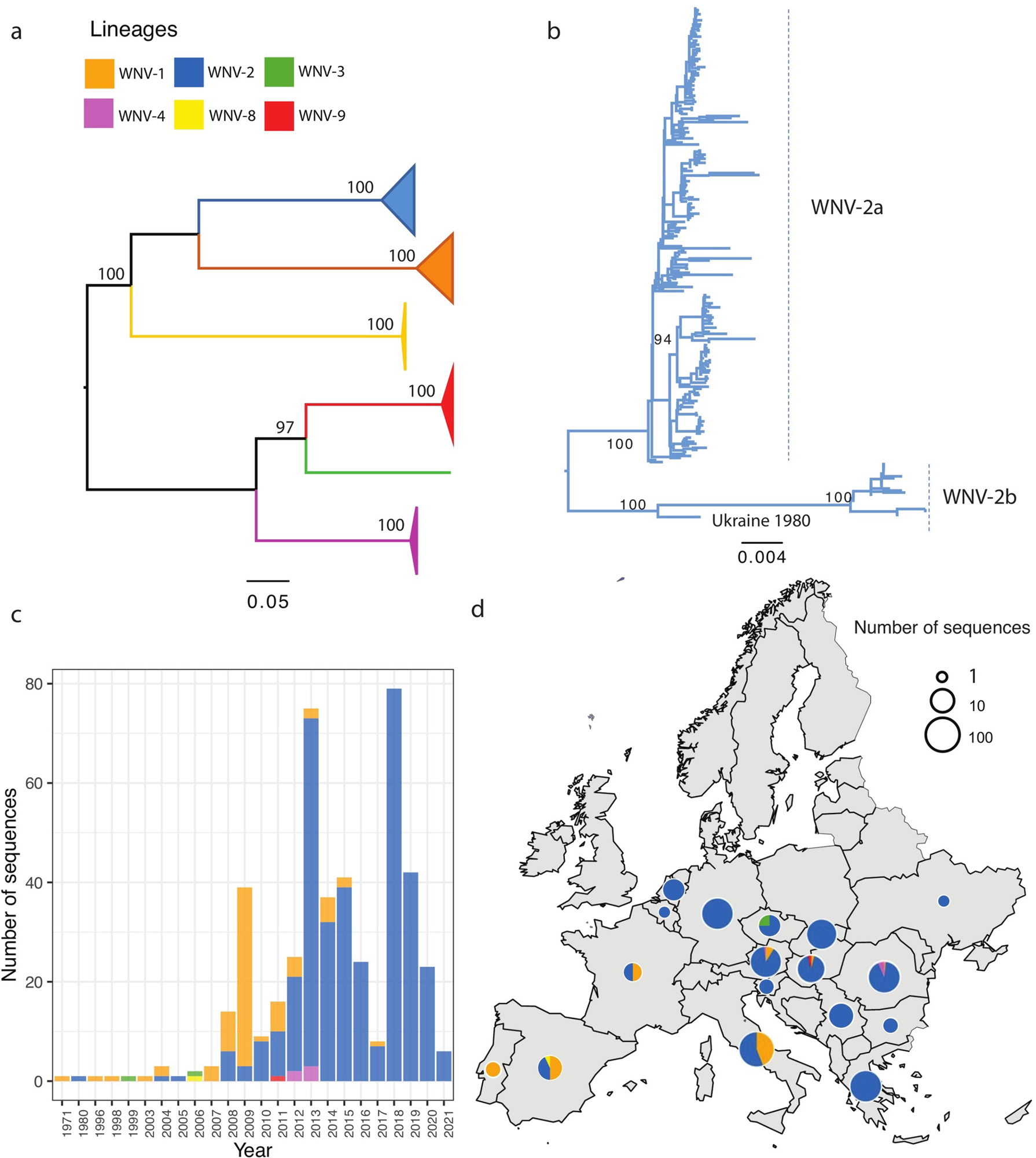Human and animal infections by mosquito-borne viruses have become a major public health concern worldwide. In Europe, the spread of the West Nile virus (WNV) has been progressively increasing in many geographical regions over the past decades. This virus can cause severe infection in humans.
WNV is an enveloped, single-stranded RNA virus transmitted to humans and animals via mosquitoes as vectors and birds as amplifying reservoir hosts. Nine distinct lineages of WNV have been identified worldwide, with WNV-1 and WNV-2 being the most predominantly identified strains in humans and animals. So far, strains WNV-3 to WNV-9 have been detected in mosquitoes, birds, equines, and amphibians.
WNV was first detected in Europe in 1960. Since 1996, an induction in WNV outbreaks has been noted in Southeast and Central Europe. In recent years, an uprise in cases of WNV-1 and WNV-2 has been detected in Europe, which can significantly impact human and animal health.
In this study, scientists have explored the transmission dynamics of WNV in Europe and evaluated the factors responsible for WNV transmission.
Study design
The scientists incorporated WNV genome sequences, ecological data, and epidemiological data into phylodynamic models to map the evolution and transmission history of WNV in Europe. They developed spatially explicit phylogeographic models to determine the impact of different factors on viral dispersal direction and velocity.
Furthermore, they used a skygrid-generalized linear model (GLM) to evaluate how changes in environmental temperature and biodiversity may predict the variations in viral genetic diversity during the past two decades.
Important observations
The study found distinct evolutionary pathways for WNV-1 and WNV-2 lineages and WNV-2a and WNV-2b sub-lineages in Europe. Of six lineages found in Europe, WNV-2a was identified as the predominant sub-lineage, accounting for 73% of publicly available viral sequences obtained from Europe. This sublineage was found to spread to at least 14 countries.
 Phylogenetic analysis of WNV full and partial nucleotide sequences detected from Europe. The evolutionary distances were computed using the optimal GTR+I model, the phylogenetic tree was constructed with the Maximum likelihood (ML) method. Bootstrap values are given for 1000 replicates. (a) ML tree of all lineages found in Europe. The branches of lineages are all collapsed and shown as rectangles; (b) The subtree of WNV-2 sequences; (c) The WNV lineages distribution over time using the same color showing on the tree; (d) The geographical distribution of WNV lineages. Map with a small pie chart showing the total number of sequences detected (on a logarithmic scale) per country, with each slice proportional to the number of distinct WNV lineages within that country. The European shapefile used in the study was obtained from Data and Maps for ArcGIS (formerly Esri Data & Maps, https://www.arcgis.com/home/group.html?id=24838c2d95e14dd18c25e9bad55a7f82#overview) under a CC-BY 4.0 license.
Phylogenetic analysis of WNV full and partial nucleotide sequences detected from Europe. The evolutionary distances were computed using the optimal GTR+I model, the phylogenetic tree was constructed with the Maximum likelihood (ML) method. Bootstrap values are given for 1000 replicates. (a) ML tree of all lineages found in Europe. The branches of lineages are all collapsed and shown as rectangles; (b) The subtree of WNV-2 sequences; (c) The WNV lineages distribution over time using the same color showing on the tree; (d) The geographical distribution of WNV lineages. Map with a small pie chart showing the total number of sequences detected (on a logarithmic scale) per country, with each slice proportional to the number of distinct WNV lineages within that country. The European shapefile used in the study was obtained from Data and Maps for ArcGIS (formerly Esri Data & Maps, https://www.arcgis.com/home/group.html?id=24838c2d95e14dd18c25e9bad55a7f82#overview) under a CC-BY 4.0 license.
The study findings revealed that WNV-2a had evolved into two major co-circulating clusters (clusters A and B) in the past two decades and transmitted to the west (cluster A) and south (cluster B). Both clusters originated from Central Europe and showed distinct dynamic history and transmission patterns.
The scientists hypothesized that WNV-2a was first introduced to Europe via long-distance migratory birds. During its circulation in local bird populations and other hosts, WNV-2a evolved, diversified, and transmitted throughout the European continent.
The dispersal velocity of WNV-2a was estimated to be as high as 88 to 215 kilometers/year, which correlated to bird movements. Agricultural land use was identified as a strong factor driving the spread of WNV.
Specifically, the factors related to crops and livestock production, such as coverage of agricultural land, pasture, cultivated and managed vegetation, and livestock density, showed positive associations with the dispersal velocity and transmission direction of WNV. A positive association was also observed between WNV transmission direction, wetland coverage, and migratory bird flyways.
The scientists highlighted that the regions with high-level agricultural activities might have influenced the dispersal velocity of WNV and its direction of transmission in Europe. As mentioned by the scientists, high-level agricultural activities are associated with a significant loss of the natural ecosystem, a reduction of mosquito and bird diversity, and an induction of aquatic habitats. All these factors can increase the transmission of vector-borne pathogens.
Furthermore, an alteration in birds' migration routes due to the loss of habitats can influence the transmission of WNV to new territories. The study found higher transmission of WNV to urban locations, where the abundance of common house mosquitoes is considerably high because of the availability of artificial aquatic habitats, the presence of warmer climates, and the lower abundance of predators.
Study significance
The study finds a high lineage diversity of WNV in Europe. Agricultural land use has the highest impact on the direction and velocity of WNV transmission, which has been directly associated with urbanization and bird habitat change.
The scientists highlight the need to strengthen virological surveillance in Central Europe, where WNV outbreaks are more likely to occur. Increased surveillance is also necessary in regions with high farming density.